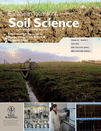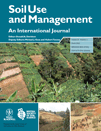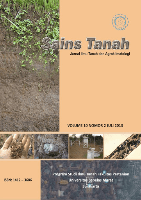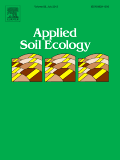
CANADIAN JOURNAL OF SOIL SCIENCE
Scope & Guideline
Cultivating Insights for Healthier Ecosystems
Introduction
Aims and Scopes
- Soil Health and Management:
Research on practices that enhance soil health, including tillage methods, cover cropping, and organic amendments, with a focus on their impacts on soil properties and agricultural productivity. - Soil Chemistry and Biology:
Studies investigating the chemical and biological properties of soil, including nutrient cycling, microbial activity, and the effects of contaminants, which are essential for understanding soil fertility and ecosystem health. - Environmental Impact of Soil Practices:
Analysis of how various soil management practices influence environmental factors such as greenhouse gas emissions, water quality, and soil erosion, emphasizing sustainable practices. - Soil Classification and Surveying:
Research focused on the classification of Canadian soils, including the development of new methodologies and frameworks for soil mapping and assessment. - Indigenous Knowledge and Soil Science:
Exploration of the integration of Indigenous knowledge systems with contemporary soil science practices, fostering collaboration and recognition of traditional ecological knowledge.
Trending and Emerging
- Sustainable Agricultural Practices:
There is a growing emphasis on studies related to conservation agriculture, including no-till practices and cover cropping, which aim to improve soil health and reduce environmental impact. - Climate Change and Soil Interaction:
Research exploring the interactions between soil management practices and climate change effects, particularly regarding soil carbon dynamics and greenhouse gas emissions, is on the rise. - Indigenous Perspectives in Soil Science:
The integration of Indigenous knowledge and practices into soil management and research is gaining prominence, reflecting a broader trend towards inclusivity and respect for traditional ecological knowledge. - Digital Soil Mapping and Precision Agriculture:
The application of advanced technologies, such as remote sensing and machine learning for soil mapping and monitoring, is increasingly featured, highlighting the journal's adaptation to modern methodologies. - Soil Microbial Ecology:
Emerging studies focusing on the role of soil microorganisms in nutrient cycling and soil health are becoming more common, reflecting a deeper understanding of soil biology's importance.
Declining or Waning
- Traditional Soil Fertility Studies:
Research centered solely on conventional soil fertility, without considering broader environmental impacts or sustainable practices, has decreased as interdisciplinary approaches gain traction. - Soil Erosion Studies:
While still relevant, the frequency of studies focusing exclusively on soil erosion has declined as new methodologies and integrated approaches to soil management emerge. - Non-Agroecological Soil Research:
Research that does not connect soil science with agroecological principles has waned, reflecting a growing recognition of the need for sustainability in agricultural practices.
Similar Journals

EURASIAN SOIL SCIENCE
Illuminating the path to better earth and soil practices.EURASIAN SOIL SCIENCE, published by PLEIADES PUBLISHING INC, is a premier journal dedicated to advancing knowledge in the fields of soil science and earth-surface processes. With an ISSN of 1064-2293 and an E-ISSN of 1556-195X, this journal has been a key resource for researchers and professionals from its inception in 1992 and continues to thrive as it converges toward 2024. Situated in the United States, EURASIAN SOIL SCIENCE has achieved notable recognition, attaining a Q2 ranking in both Earth-Surface Processes and Soil Science categories as of 2023. Its Scopus rankings further underscore its importance, with Earth and Planetary Sciences placing it at #81/179 and Agricultural and Biological Sciences ranking it at #80/159. Engaging a global audience, this journal publishes cutting-edge research articles, reviews, and case studies that address critical issues related to soil health, conservation, and management. Though currently not open access, the journal offers valuable insights and fosters collaboration among scientists and practitioners, underscoring its vital role in enhancing the understanding of soil dynamics and sustainability.

EUROPEAN JOURNAL OF SOIL SCIENCE
Uncovering Solutions for Soil SustainabilityEUROPEAN JOURNAL OF SOIL SCIENCE, published by Wiley, stands as a leading platform in the field of soil science, recognized for its contributions to the understanding of soil ecology, management, and sustainability. With an impressive impact factor and a distinguished Q1 ranking in Soil Science, this journal has recently ranked 23rd out of 159 in its category on Scopus, placing it in the 85th percentile among its peers. Covering a wide array of topics as it converges into the future, from 1994 to 2024, the journal aims to disseminate groundbreaking research and innovative methodologies that address the pressing challenges of soil degradation and environmental sustainability in Europe and beyond. Although it is not an open access journal, the EUROPEAN JOURNAL OF SOIL SCIENCE remains a vital resource for researchers, professionals, and students seeking to deepen their understanding and explore the latest advancements in soil science.

Journal of Soil Science and Plant Nutrition
Fostering sustainable practices through cutting-edge research.The Journal of Soil Science and Plant Nutrition, published by SPRINGER INT PUBL AG, is a premier academic journal dedicated to advancing the fields of agronomy, plant science, and soil science. With an impressive Q1 ranking in both Agronomy and Crop Science and Plant Science, alongside a Q2 ranking in Soil Science, this journal stands at the forefront of innovative research and knowledge dissemination. Annually indexed in key databases, it provides a platform for high-quality research articles that explore the complex interactions between soil health and plant nutrition, contributing significantly to sustainable agricultural practices. Although it does not offer open access options, the journal is accessible through various academic institutions and libraries, ensuring a wide readership. With its emphasis on impactful findings, the journal is an essential resource for researchers, professionals, and students aiming to further their understanding and application of soil and plant science in an ever-evolving global context.

SOIL USE AND MANAGEMENT
Exploring the nexus of agriculture and environmental stewardship.SOIL USE AND MANAGEMENT is a premier academic journal published by Wiley, focusing on the critical domains of Agronomy, Crop Science, Pollution, and Soil Science. With an ISSN of 0266-0032 and an E-ISSN of 1475-2743, the journal has established itself as a vital resource in the field since its inception in 1985. Operating from its U.S. headquarters in Hoboken, NJ, SOIL USE AND MANAGEMENT boasts impressive Q1 rankings across its relevant categories, indicating its standing in the top tier of research journals. Notably, it is ranked 48th out of 406 journals in Agronomy and Crop Science and holds an 88th percentile position, as well as a commendable rank of 26th out of 159 journals in Soil Science, underscoring its influence and reach. This journal serves as an essential platform for researchers, professionals, and students dedicated to sustainable soil management practices and understanding soil's role in agricultural productivity and environmental health. Although it does not offer Open Access, its rigorous peer-review process ensures the publication of high-quality original research, reviews, and case studies critical for advancing knowledge and practice in the field. This journal is crucial for anyone engaged in soil science and its related disciplines, encouraging innovative approaches to challenges facing soil use and management today.

SAINS TANAH
Fostering Sustainable Practices in Soil and Crop ManagementSAINS TANAH is a renowned peer-reviewed journal that focuses on the fields of agronomy, soil science, and environmental studies, published by Universitas Sebelas Maret Surakarta in Indonesia. Established as an Open Access platform since 2001, it aims to disseminate high-quality research that addresses critical issues in soil health, crop management, and pollution, thereby fostering sustainable agricultural practices. With its current impact factor demonstrating a Category Quartile ranking of Q3 and Q4 in major areas such as Agronomy and Crop Science, Atmospheric Science, and Pollution, SAINS TANAH serves as an essential resource for researchers, professionals, and students dedicated to advancing knowledge and solutions in these vital fields. By providing a collaborative environment and upholding rigorous academic standards, the journal not only highlights the significance of Indonesian research contributions but also aims to connect local insights with global agricultural and environmental challenges.

APPLIED SOIL ECOLOGY
Uncovering the Secrets Beneath Our FeetApplied Soil Ecology, published by Elsevier, is a premier journal dedicated to advancing the field of soil ecology through rigorous research and innovative methodologies. With an impressive impact factor and a consistent placement in the Q1 quartile across various categories including Agricultural and Biological Sciences, Ecology, and Soil Science, this journal underscores its significance in the scientific community. The journal's scope encompasses critical areas such as soil biology, microbial ecology, and the role of soils in ecosystem services, aiming to foster collaboration and knowledge exchange among researchers, professionals, and students. The convergence of research efforts from 1994 to 2024 highlights its commitment to maintaining current and relevant discourse within the field. While open access options are not available, the quality and depth of the articles published ensure that the latest findings and discussions are accessible through institutional subscriptions. With a strong focus on empirical studies and applied research, Applied Soil Ecology is an essential resource for anyone interested in the complexities of soil ecosystems and their impact on the environment.

Malaysian Journal of Soil Science
Exploring Innovations in Agronomy and Soil Management.The Malaysian Journal of Soil Science, published by the Malaysian Society of Soil Science, serves as a vital platform for disseminating high-quality research in the fields of Agronomy and Crop Science as well as Soil Science. With an ISSN of 1394-7990, this peer-reviewed journal has made significant strides since its establishment in 2009, currently positioned in the Q2 quartile for both categories as of 2023. The journal aims to advance knowledge surrounding soil health and management practices, particularly within the Malaysian context, while also addressing global soil science issues. Despite being based in Malaysia, it welcomes contributions from a diverse range of geographies and viewpoints, enriching the academic discourse. Researchers and practitioners in this field will find a wealth of innovative studies and findings that reflect the current trends and challenges in soil management. Given its current rankings in Scopus, the journal plays a crucial role in shaping the future of soil science, making it indispensable for anyone dedicated to advancing research and practical applications in agricultural and environmental sciences.

ACTA AGRICULTURAE SCANDINAVICA SECTION B-SOIL AND PLANT SCIENCE
Bridging Science and Practice in Agronomy and Soil ScienceACTA AGRICULTURAE SCANDINAVICA SECTION B-SOIL AND PLANT SCIENCE, published by Taylor & Francis AS, is a distinguished journal dedicated to the fields of Agronomy, Crop Science, and Soil Science. With an impressive impact factor, and categorized in Q2 for both Agronomy and Crop Science and Soil Science as of 2023, this journal is an essential resource for researchers, professionals, and students aiming to advance their understanding of soil-plant interactions and sustainable agricultural practices. Operating since 1992 and continuing through to 2024, ACTA aims to publish high-quality, peer-reviewed research that encourages the applicability of advanced scientific knowledge in real-world agricultural settings. While the journal is not open access, it remains widely accessible through institutional subscriptions, reflecting its commitment to disseminating essential findings and fostering innovation in soil and plant science worldwide. Nestled in the vibrant academic environment of Norway, ACTA AGRICULTURAE SCANDINAVICA serves as a key platform for nurturing groundbreaking research that informs sustainable agricultural policies and practices globally.

Spanish Journal of Soil Science
Exploring Innovations in Soil ResearchThe Spanish Journal of Soil Science is a prestigious open-access journal published by FRONTIERS MEDIA SA since 2011. Based in Switzerland, this journal serves as a vital platform for disseminating innovative research and applications within the field of soil science. With its commitment to accessibility, the journal enables researchers, professionals, and students from around the globe to contribute to and benefit from its wealth of knowledge. As of 2023, it holds a respectable Q3 category ranking in soil science and is positioned at #88 out of 159 in the Scopus rankings for Agricultural and Biological Sciences. The journal aspires to foster collaboration and communication among soil scientists, encouraging the exploration of contemporary soil issues, sustainable practices, and advancements in technology. Its open-access model ensures that the latest findings are freely available, promoting a broader impact in environmental and ecological studies.

SOIL SCIENCE SOCIETY OF AMERICA JOURNAL
Fostering Sustainable Practices Through Soil StudiesWelcome to the SOIL SCIENCE SOCIETY OF AMERICA JOURNAL, a premier publication in the field of soil science, published by WILEY. With a distinguished history dating back to 1976, this journal has consistently provided a platform for researchers to share innovative findings and insights into soil’s critical role in agricultural and ecological systems. Featuring an impressive Q1 category ranking in Soil Science and positioned within the top 25% of its field according to Scopus, this journal is recognized for its impactful contributions to advancing our understanding of soil dynamics. While not an open-access journal, it remains a valuable resource for academics and professionals alike, with distinguished articles that meet the highest scientific standards. As it enters its converged years from 1976 to 2024, the journal aims to continue shaping the future of soil research, offering valuable knowledge to students, researchers, and practitioners dedicated to sustainable land management and environmental preservation.